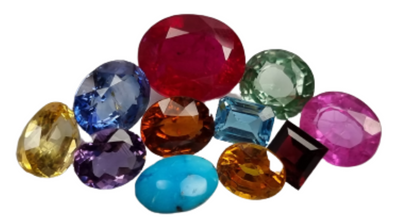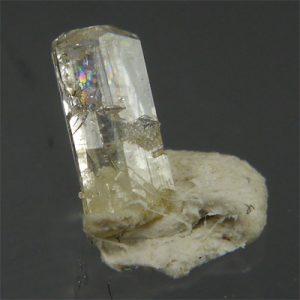Milarite: Gemstone Information
Milarite is KCa2AlBe2Si12O3005H2O and a member of the osumilite group in which it forms transparent to translucent colorless to pale yellow or green prismatic crystals, typically well formed, of the hexagonal system. The hardness is 5.5–6 and the SG 2.46–2.61. The RI for the ordinary and extraordinary rays is 1.532–1.551 and 1.529–1.548, uniaxial negative with birefringence 0.003. Milarite is found in vugs in granites and syenites or in hydrothermal veins.
Large crystals are found in the Jose Pinto pegmatite, Jaguarcu, Coronel Fabriciano, Minas Gerais, Brazil and smaller examples at several Swiss localities though not in the Val Milar after which it was named! A sapphire-blue scandium-bearing variety with RI 1.549 and 1.560, birefringence 0.011 with pleochroism strong blue to green has been reported from Tamil Nadu, India. The Sc content was 1.9%. The Mineralogical Record 35(5) carries a useful paper showing Alpine milarite crystals up to 1 cm.
Milarite: Unveiling the Allure and Advantages of a Gemstone Treasure
Milarite, a captivating member of the borosilicate mineral family, mesmerizes with its vibrant hues and unique properties. Despite its relative rarity, milarite has earned a special place in the world of gemstones, cherished for its exquisite beauty and potential benefits. In this article, we delve into the origins, characteristics, and advantages of milarite, shedding light on its allure and significance.
Origins and Formation
Milarite derives its name from the Milar Valley in Russia, where it was first discovered in the 19th century. It is primarily found in pegmatite deposits, where it forms as a secondary mineral through the alteration of primary borosilicate minerals such as tourmaline and elbaite. Milarite is often associated with other minerals such as quartz, feldspar, and mica, contributing to the diverse and intricate compositions of pegmatite formations.
Physical and Optical Properties
One of the defining features of milarite is its vibrant coloration, ranging from translucent green to yellow-green, with occasional hints of blue or brown. It typically occurs as prismatic crystals with a vitreous luster and a transparent to translucent appearance. Milarite crystals may exhibit striations or growth patterns, adding to their visual appeal and complexity.
Milarite’s crystal structure and chemical composition give rise to its unique optical properties, including pleochroism, birefringence, and fluorescence. Under certain lighting conditions, milarite crystals may display a mesmerizing play of colors, further enhancing their beauty and allure.
Metaphysical and Healing Properties
Milarite is revered for its metaphysical and healing properties, believed to resonate with energies of harmony, balance, and emotional healing. It is often associated with the heart and throat chakras, facilitating communication, compassion, and emotional expression.
In the realm of emotional healing, milarite is said to promote inner peace, soothe frayed nerves, and alleviate stress and anxiety. It is believed to enhance empathy, understanding, and forgiveness, fostering deeper connections with oneself and others.
Milarite’s soothing energies are also thought to stimulate creativity, inspiration, and intuition, making it a valuable tool for artists, writers, and anyone seeking to unlock their creative potential. It is said to clear mental fog, enhance mental clarity, and promote a sense of clarity and purpose.
Uses and Applications
Despite its relative rarity, milarite has found various applications in the realm of gemology, lapidary arts, and metaphysical practices. Its vibrant colors and unique properties make it a sought-after gemstone for use in jewelry, ornamental objects, and decorative carvings. Milarite crystals may be faceted or polished into gemstones, cabochons, and beads, showcasing their natural beauty and brilliance.
In metaphysical practices, milarite is often used as a meditation aid, facilitating deep states of relaxation, introspection, and spiritual connection. It is believed to enhance psychic abilities, intuition, and spiritual insights, guiding individuals on a journey of self-discovery and inner exploration.
Care and Maintenance
To preserve its beauty and integrity, milarite jewelry should be handled with care and cleaned gently using a soft, damp cloth. Avoid exposing milarite to harsh chemicals or abrasive cleaners, as these may damage its delicate surface and affect its luster. Store milarite jewelry separately from other gemstones to prevent scratching or abrasion, and avoid exposing it to prolonged sunlight or heat, as this may cause fading or discoloration over time.
Conclusion
Milarite stands as a gemstone of rare beauty and profound significance, captivating hearts and minds with its vibrant colors and metaphysical properties. From its origins in pegmatite deposits to its diverse applications in jewelry and metaphysical practices, milarite continues to intrigue and inspire individuals around the world.
Whether used as a decorative accent, meditation aid, or tool for emotional healing, milarite serves as a reminder of the inherent beauty and wisdom present in the natural world. With its soothing energies and vibrant colors, milarite invites us to explore the depths of our innermost selves, guiding us on a journey of self-discovery and spiritual growth.





